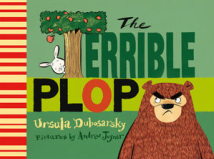 The Terrible Plop by Ursula Dubosarsky with pictures by Andrew Joyner
Penguin Books for Children, 2009
The Terrible Plop is a book that starts
With a PLOP that trembles the rabbits' hearts.
They start to run and when they do
The forest critters follow, too.
While all the creatures run away
The big brown bear decides to stay.
What will happen when the bear goes to see
The PLOP that's causing everyone to flee?
In rollicking text that has a pleasing rhyme,
This book is joy at read-aloud time.
A touch of mystery, colourful art,
and humour set Terrible Plop apart.
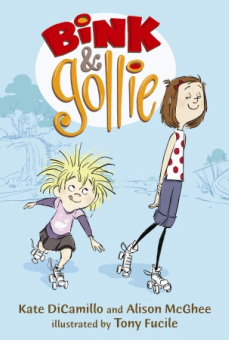 Bink & Gollie by Kate DiCamillo and Alison McGhee, illustrated by Tony FucileCandlewick, 2010 Bink, a small girl with wild blonde hair, lives in a homey little cottage while Gollie, a tall brunette, lives in a tidy modern home in a tree (yes, a treehouse!). Through the course of three short chapters, the girls have small adventures which demonstrate the ups and downs of friendship. Bink & Gollie is absolutely delightful. The girls, apparent best friends and near-constant companions, seem to have little in common. Gollie has an outwardly calm demeanor and uses a charmingly old-fashioned vocabulary - '"Greetings, Bink," said Gollie. "I long for speed"' (p. 3). Bink, on the other hand, has a disheveled look about her and her actions are propelled by emotion and other drives, such as hunger. Together, they work to find compromises when they have disagreements and do their best to see one another's perspective. The illustrations are as charming as the characters themselves. Tony Fucile uses colour to accentuate components in his predominantly grey-scale drawings, from signs in store windows to a new goldfish. Bink and Gollie themselves are always in full colour, and one touch I especially enjoyed was the smudge of orange to indicate Fred in the frozen pond on the final page. Although there are many details within the illustrations (like Gollie's treehouse, which I now covet), care was taken not to detract from the two girls. A wonderful collaboration (which makes me wonder if DiCamillo is more like Bink and McGhee is more like Gollie, or vice versa*) with an endearing result. *Read this article to find out!
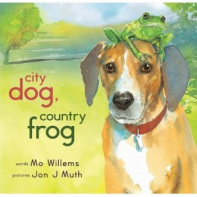 City dog, country frog by Mo Willems, illustrated by Jon J. Muth
Hyperion, 2010
When City Dog arrives for a visit to the country in springtime, he heads off for a gleeful leash-free run and encounters Country Frog. When asked why he is sitting on a rock, Country Frog replies that he is waiting for a friend, but that City Dog will do. Thus begins a friendship that lasts through the seasons.
Picture books of friendship don't come much more poignant than this. Mo Willems is a master of subtly injecting emotion into the play of words and images in his books, and combining his words with Jon J. Muth's expressive watercolour illustrations is a match made in heaven. The colours capture the essence of the four seasons and the animals have obvious personalities. City Dog's tail and ears are consistently perfect, and in the image below his confusion at Country Frog's absence is evident. The illustrations extend Willems' carefully selected words and, in keeping with the origins of the word, beautifully illuminate them.
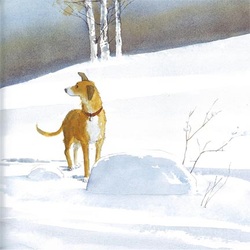 Image from: http://32pages.ca/2011/01/07/a-dog-a-frog-and-an-apology/ I'm not going to lie: I've read this book three times and I've been misty-eyed on every occasion. You see, Country Frog doesn't survive past autumn and City Dog persists in waiting for him to reappear into the following spring. (Lest you think the book ends on a sad note, rest assured that City Dog befriends another country creature.) Bittersweet and beautiful it most certainly is, and well worth a look.
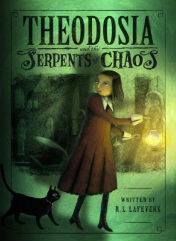 Theodosia and the Serpents of Chaos by R. L. LaFeversHoughton Mifflin, 2007 Theodosia's parents both study ancient Egypt and work for London's Museum of Legends and Antiquities. As a result, eleven-year-old Theodosia spends almost all her time at the museum which is wonderful since she is interested in antiquities, but it's not so great because she can sense the ancient curses that surround many of the Egyptian artifacts. When her mother finds and brings the legendary jeweled Heart of Egypt to the museum, Theodosia is not the only person who knows of its devastating powers, but it appears that she may the only one who can save Britain from the doom to come. What a rip-roaring adventure! It's almost like The Mummy but with children as protagonists (and I mean that in the best possible way: action, adventure, Egyptian curses, chase scenes, but unfortunately for me no Medjai, sigh). Serpents of chaos also involves pickpockets, a stowaway, hidden burial chambers, a demonized cat, and a secret brotherhood. How's that for excitement! Amidst it all, Theodosia as a character is solid as a rock. She is clever, independent, daring, and is rather attached to her cat's presence while she sleeps in an empty sarcophagus most nights (her father is the Head Curator and rarely leaves his place of work while his wife is away on a dig). She also realizes that her ability to sense curses makes her different from her parents, and as a result she is essentially an expert in neutralizing Egyptian curses due to her extensive studies while she is stuck at the museum. The adults who surround her on a daily basis fail to recognize her knowledge, which causes Theodosia much frustration. This frustration drives many of her actions throughout the book, and she is determined to prove to her parents that she is of great worth. The historical setting is an interesting one. The events occur in what seems to be early 1914, and the author does a stand-up job of simply explaining the complicated international relations that existed at that time and which provide a backdrop to the significance of the Heart of Egypt. I'm curious to read the sequels to Theodosia and the Serpents of Chaos for many reasons, but one of the main ones is to find out how the advent of the First World War will be incorporated into the plot if, indeed, it is. This is a novel that should appeal to boys and girls with its wit, adventure, and magic, and will likely spur interest in ancient Egypt as well.
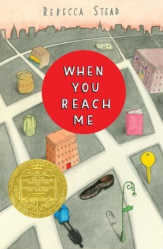 When you reach me by Rebecca Stead
Wendy Lamb Books (Random House), 2009
It's 1978 and Miranda is in sixth grade in New York City. She and her best friend Sal are drifting apart, and mysterious letters keep appearing which are addressed to her and accurately predict the future. Miranda doesn't know what to make of the notes and the events they describe, but her absolute favourite book - A wrinkle in time by Madeleine L'Engle - may turn out to be the key to the mystery.
There is so much going on in this brief (197-page) novel that it would take another few paragraphs to write a synopsis that covers the key plot points. I do not say this disparagingly in the least, as the author handled the story's complexities extraordinarily deftly and, for the most part, linearly. It is quite a feat, as is the fact that I hadn't the slightest clue who the mysterious letter-writer was until it was revealed. In fact, it is a book I intend to re-read in order to discover what I missed the first time.
The characters are what made this book a joy for me to read. Miranda is intelligent, perceptive, and valiantly trying to make some sense of the world around her. I appreciated the little details about her inner life, such as how she balances her fears with her realism by approaching people she's afraid of to ask the time so she can see that they are, in fact, not so scary. Also, she is aware of the little moments of poetry in daily life while not noticing that a close friend eats a special diet, which is that odd mix of worldliness and obliviousness that can be found in many 11-year-olds.
When you reach me is, at its essence, about the interactions between people in Miranda's world: Miranda's relationships with her mother and her mother's boyfriend, sixth-grade friendships that form almost as mysteriously as they end, and Miranda's observations of the people within her neighbourhood. The characters are lively and real and had their own things going on outside the walls of the story, especially Marcus and Julia. There always seemed to be a lot going on for Miranda, even if big events didn't happen very often. And if that isn't an accurate depiction of real life, then I'm not sure what is.
When you reach me is the Newbery-winning novel of 2010 and rightly so.
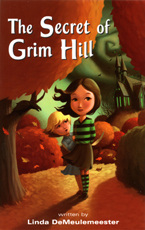 The Secret of Grim Hill by Linda DeMeulemeester
Lobster Press, 2007
Cat and her younger sister, Sookie, have just moved to a new town with their mother, and Cat is not enjoying Darkmont High at all. Soccer-playing Cat soon finds out about soccer scholarships to the nearby private Grimoire school that are earned by the winning team of a Halloween match. Despite continually hearing from Sookie and their neighbour, Jasper, that something just isn't right about Grimoire, Cat goes ahead with her daily team practices until the bizarre events of an early Halloween party change her priorities.
I was spurred to read The Secret of Grim Hill by a new student who wondered if the library had the sequels because he enjoyed this book so much. He reads a lot and very quickly, so I thought if he liked it then it must be pretty good. Happily, it is.
Cat is a realistic tween protagonist: she is easily annoyed by her younger sister, very aware of her school's social hierarchy and endeavours to climb it, fulfills her household responsibilities despite wishing she didn't have to, and is quintessentially likable. When push comes to shove, Cat's priorities are in order (soccer and family at the top with homework dead last). Sookie is as much or even more compelling as a precocious, Monopoly-loving little girl who is generally as seemingly as annoyed with Cat as Cat is with her.
The atmosphere of Grim Hill is generally light with escalating indications to the reader that something dark is afoot. DeMeulemeester's incorporation and explanations of Celtic mythology and traditions are seamlessly done, and the tension builds to a peak that is exhilarating and urgent but not full-on scary. I look forward to reading one or more of the sequels (loaned from another school library for the student mentioned earlier) to see if the Celtic theme is maintained or if other mythologies are incorporated into the series.
Overall, a solid beginning to a middle-grade fantasy series.
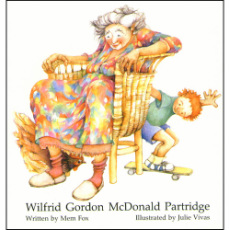 Wilfrid Gordon McDonald Partridge by Mem Fox, illustrated by Julie Vivas
Kane Miller, 1984
Wilfrid Gordon McDonald Partridge is four years old and lives next door to an "old people's home," where he has numerous friends. He overhears that his best friend Miss Nancy lost her memory, but Wilfrid doesn't know what memory is. When he asks all his friends at the home about it, he gets a variety of answers that he interprets in his own way to help Miss Nancy.
What a truly lovely book. It contains what I consider to be the essential components of a wonderful picture book: a deceptively simple story, concisely told and relatable, with gorgeous illustrations. Mem Fox and Julie Vivas certainly deliver that here, and the collaboration is such that the sum of the writing and illustrations is greater than the two parts. Every word is absolutely necessary, and each illustration is luminous and expressive.
In my experience, there are not many picture books that address intergenerational friendships. In fact, this is the only one I've come across in which the relationships depicted are purely friendships and the child is not related to any of the elderly characters. It is refreshing and wonderful and I hope there are more like it that I simply haven't found yet.
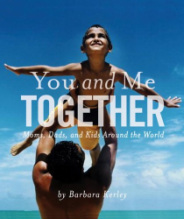 You and me together: Moms, Dads, and kids around the world by Barbara KerleyNational Geographic Society, 2005With spare, rhythmic text and gorgeous photographs from all around the world, You and me together looks at the common experiences shared by parents and children regardless of culture, language, nationality, or religion. This is an absolutely gorgeous book. The photos all have a parent with one or more children partaking in activities described by the text, from playing with a ball to riding ponies to just having a chat. Each photo in the book (including the cover image) has a brief caption at the back explaining where the photograph was taken and something interesting about the subjects or event depicted in the image. Although North America is the continent depicted most often in the book, the images cover all continents (except Antarctica). Although one spread in particular that shows a young Karen girl gazing at her guitar-playing mother with an expression of absolute adoration just about undoes me, You and me together is chock full of lovely everyday moments between children and their parents. Most of the children depicted in the images fall within the 4- to 8-year-old age group, which is likely the target child audience. An outstanding book to demonstrate for young children the similarities and differences between cultures.
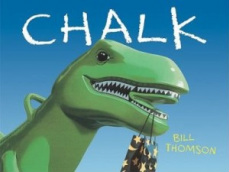 Chalk by Bill Thomson
Marshall Cavendish, 2010
On a rainy day, three children go to the park to play. When they find a bag full of sidewalk chalk and start drawing on the asphalt, they discover that whatever they draw becomes real. A sun dissipates the rain, a swarm of butterflies flies all around, and a Tyrannosaurus Rex fast becomes more terrifying than anticipated.
Wordless books are some of my favourite picture books, and Chalk is no exception. Without words, illustrations become paramount and Bill Thomson makes his acrylic and colored pencil drawings look almost like photographs: the reflections are bright and the different textures (skin, plastic, fabric) are realistic. The children's facial expressions when they discover the power of the chalk are wonderful, with one girl appearing almost crazily delighted and the boy looking very mischievous (guess who draws the carnivorous dinosaur?). I particularly loved the spread where monarch butterflies were magically taking flight from the asphalt.
Thomson uses perspective to his great advantage as well, by showing one of the frightened children fleeing up a playground ladder from below to accentuate her wide-eyed, wide-mouthed terror at being chased by a T. Rex. The perspectives he used created tension themselves, such as when the reader is in the covered slide with two of the children looking out at the dinosaur's menacing teeth, and the scene involving the demise of the T. Rex is masterfully done.
I hope Bill Thomson makes more like Chalk, as it's remarkable.
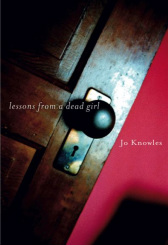 Lessons from a dead girl by Jo Knowles
Candlewick, 2007
Beautiful, popular Leah takes awkward Laine under her wing when they are in fifth grade and declares them to be friends forever. Laine is confused by the attention but happily goes along with it. Laine even goes along with Leah's insistence that they secretly "practice" for marriage together, although Laine becomes increasingly confused by what it means about her relationship with Leah. While the girls grow apart as they enter high school, Leah maintains a powerful hold over Laine until a public confrontation results in tragedy.
Knowles tackles the topic of sexual abuse between children head-on, and she does it with a remarkably delicate touch while pulling no punches. Laine's confusion and desperation to keep Leah happy, as well as the tension between Laine and Leah in the years after their "practice" ends, are well-rendered. Although there are certainly scenes that are uncomfortable as a reader, nothing is graphically presented and the narrative focuses primarily on the emotions of the characters, especially Laine as the novel is from her point of view.
Leah and Laine are three-dimensional characters with specific and evident motivations, and their respective evolutions as they grow into teenagers are unsurprising but nonetheless poignant. Although I know very little about this topic, it would appear that the author did a good deal of research to create such believable characters, and this novel was an emotional and educational introduction to the subject and will not soon be forgotten.
|











 RSS Feed
RSS Feed